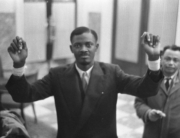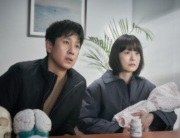Award-winning filmmaker Frederick Wiseman establishes a very clear premise for National Gallery within the first few minutes. Reminiscent of the slide presentations used in art history classes, he opens with a silent parade of photographs of paintings housed within the National Gallery in London. He follows with a similar technique to reveal interior views of the museum before it opens to the public. The building begins to “awaken” as the doors are opened and people start to move into the galleries; but it isn’t until we are treated to portrait worthy close-ups of museumgoers as they react to the paintings displayed before them that the institution fully comes to life.
The interconnection between the people and the art and the history that lies within each piece is the driving force behind this stately institution, as well as everything that follows. Wiseman uses both public and behind-the-scenes footage of everyday life at the museum to demonstrate just how deeply rooted this interconnectedness seems to be.
There is artistry in every aspect of the organization, from the choices made by staff for their daily presentations to the way each painting is displayed. Preschoolers and their parents are made aware of the amazing stories inside each painting; teens are encouraged to compare art to film; teachers are taught how to decode Medieval paintings to enrich their students’ experiences of art; adults are immersed in discussions of the place, the time, and the situation depicted in particular works; the visually impaired are provided with raised-line images of a Camille Pissarro painting to explore his composition techniques.
We observe rooms stripped and repainted to compliment a new exhibit, lighting adjusted to best display a particular piece, and an interview with the curator as he discusses the success of an exhibition in terms of the ability of paintings to “speak” to one another. Artisans hand carve and apply gold leaf as they repair damaged antique frames, employing the same techniques that were used in their creation, while conservation experts employ the latest technology and a modern philosophy to the restoration of paintings that have seen centuries of wear and tear. Scattered among these accounts of daily life at the museum are recurring vignettes of people looking at paintings, and the unmistakable implication that the artworks are active participants in the process.
Wiseman has commented that he does not like the term cinéma vérité used in connection with his documentaries. While his style is both candid and open to interpretation, he considers that he is telling his side of the story through the hours and care he puts into the editing of the extensive footage for each of his films. His personal choices are evident in his inclusion of private meetings that display an ongoing tension between factions of the administration who disagree about the need to increase outreach efforts and public involvement in the museum, juxtaposed with the focus on an overwhelmingly enthusiastic public.
People queue in the rain and cold for the opening of the museum, some appearing to have spent the night in hopes of being among the first to see that day a Leonardo da Vinci exhibit. Galleries are crowded, daily talks and events are well attended, fundraisers are overwhelmingly successful. Wiseman closes as he began, but this time sticking exclusively to portraits, a parade of faces that peer out across time in silent communion with all who stand before them today.







Leave A Comment